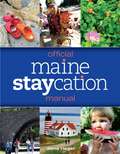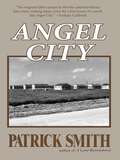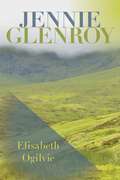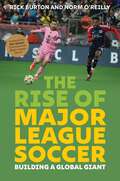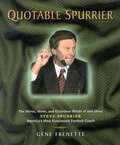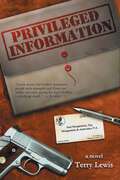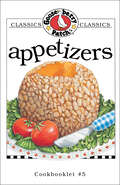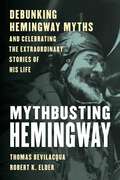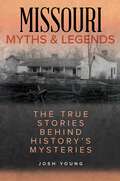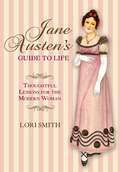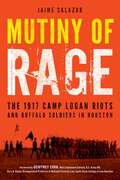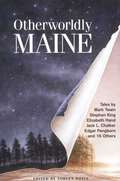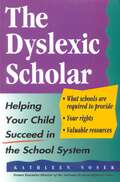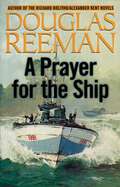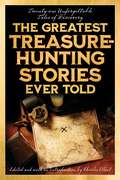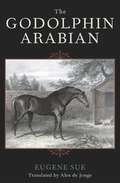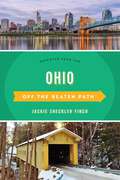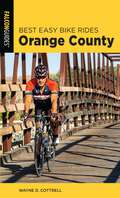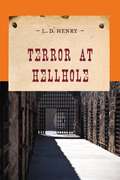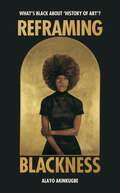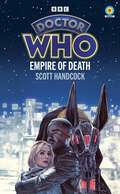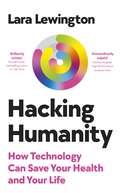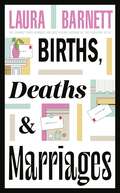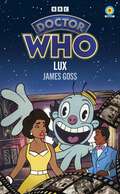- Table View
- List View
Official Maine Staycation Manual
by Dena RiegelThe Official Maine Staycation Manual is part fun-instigator, part planner, and part resource for anyone spending time in Maine. It&’s a combination inspiration and relaxation guide that will help you make the most of your staycation no matter where you are or how much time you have to spend.Feel free to open The Official Maine Staycation Manual to any random page and try any idea you find there. Build a blanket fort! Make stove-top popcorn and have movie night. Take in waterfalls, lighthouses, and state parks. Do it all! Plus there&’s an extensive resources section where you&’ll find lists of spas, whale watching options, day trip ideas, beaches, paddling excursions, and a whole lot more.Whether you have a week to play or an hour to kill you&’ll find thoughtful and fun ideas on every page.
Angel City
by Patrick D SmithAfter leaving their failed farm in West Virginia, Jared Teeter and his family make their way to Florida, with dreams of fishing, going to the beach, and running their own roadside produce stand. What they find instead is a nightmare in a migrant labor camp, where they become the indentured servants of a soulless crew chief and his mindless henchmen. Vacillating between hope and despair, Jared must stay alert—and alive—to rescue his own family and the prisoners around him from a life of continued degradation. In the year before he wrote Angel City, Patrick Smith did what he called &“physical research," disguising himself and joining migrant crews as they picked whatever vegetable was in season. He mentally recorded the events he encountered and wrote the novel is just a few weeks. His reason for writing Angel City? &“The first step toward eliminating injustice is to expose it," he said. Angel City was made into a TV movie in 1980.
Jennie Glenroy
by Elisabeth OgilvieJennie and Alick Glenroy arrived in Maine with nothing, not even their names, starting anew in a different land, leaving the turmoil and violence of Scotland behind them. Almost twenty years later, the "Godless Glenroys" are a prosperous, though sometimes controversial, family. Alick is the proprietor of a successful shipyard, and Jennie has raised their five children to think for themselves, a trait that occasionally raises the ire of their staid neighbors.The Glenroys, along with the other inhabitants of Whittier, find themselves facing issues that they've long been sheltered from: slavery, malice, and violence. Jennie and Alick must defend their children against malicious accusations and guide them through the trials of adolescence, but also allow them the independence and space to grow into intelligent and principled adults. When a figure from their fugitive past sails into town, everything they have worked to build over the past twenty years is in danger of being torn asunder, but all they can do is face these new challenges with the same courage and persevering spirit that carried them over Highland mountains so many years before.
Rise of Major League Soccer: Building a Global Giant
by Norm O'Reilly Rick BurtonDiscover the strategy behind Major League Soccer's rapid rise as it aims to compete with global football giants.Major League Soccer, armed with its massive Apple sponsorship, the imminent arrival of the 2026 FIFA World Cup in North America, the hosting of the COPA America tournament in 2024, and the signing of the game&’s GOAT, Lionel Messi, could make MLS one of the world&’s biggest leagues and one, within the next five years, capable of keeping credible company with European leagues such as La Liga, Serie A, Ligue 1, and Bundesliga. In The Rise of Major League Soccer: Building a Global Giant, experienced sports business experts Rick Burton and Norm O&’Reilly dig into the slow but sure growth of Major League Soccer in North America and the advent of major European teams like Manchester United, Real Madrid, Chelsea, FC Barcelona, Arsenal, Inter Milan, Bayern Munich, Liverpool, and others attracting huge fan bases in the United States. For soccer enthusiasts, sports business professionals, and anyone curious about the future of American sports, this book is an essential read that captures MLS&’s journey to becoming a global powerhouse.
Quotable Spurrier: The Nerve, Verve, and Victorious Words of and about Steve Spurrier, America's Most Scrutinized Football Coach
by Gene FrenetteSteve Spurrier is the epitome of a national sports figure either loved or hated with enthusiasm by millions.
Privileged Information
by Terry LewisTerry Lewis's second courtroom novel features Ted's partner, Paul Morganstein. While defending his late brother's best friend on a murder charge, Paul obtains privileged information (which he is ethically bound not to disclose) leading him to conclude that his client committed another murder thirty years ago. The victim? Paul's brother. Paul takes on the biggest company with the deepest pockets in the Panhandle, defending a client who, incredibly, seems less concerned than his attorney that he's facing murder one. The deeper Paul digs, the more likely it seems his client not only killed the vice president of Pinnacle Paper Company but knows a lot more than he'll say about the death of Paul's brother, David. Investigation into the Pinnacle case is turning up new evidence that reveals more about David's life—and death—than Paul can deny. Does Paul honor the sacred oath of confidentiality and allow his brother's murderer to go free, or does he breach that duty in the interest of a higher morality, a greater justice? Moreover, will his client decide that there is really only one way to be sure that Paul doesn't disclose this &“privileged information"?
In the Presence of Grizzlies: The Ancient Bond Between Men And Bears
by Doug Peacock Andrea PeacockWinner of ForeWord Magazine's 2006 Gold Award for Nature Book of the YearThe most comprehensive and compelling chronicle of human–grizzly-bear interactions ever written, In the Presence of Grizzlies (formerly published as The Essential Grizzly) examines the fragile bond between ourselves and the quintessential alpha predator. Doug and Andrea Peacock contend that the conservation of big, wild, sometimes dangerous animals is essential for the survival of our own species and for the sense of humility necessary for rational thought. They explore a wide range of human-grizzly encounters through interviews with biologists, mauling victims, hunters, and photographers. To these they add unique portraits—sketches of real grizzlies from the bear&’s viewpoint—and up-to-date commentary on such developments as the declassification of grizzlies as an endangered species. In the Presence of Grizzlies eclipses all existing books on bear behavior and bear attacks, providing readers with a twenty-first-century context for revisiting the original shudder of Homo sapiens—the bear in the cave of our genesis.
Appetizers Cookbook
by Gooseberry PatchGet a taste of Gooseberry Patch in this collection of over 20 favorite appetizer recipes! Gooseberry Patch Appetizers is filled with recipes that are not only good, but also simple to make…Tropical Chicken Wings, Spinach Pinwheels, Jalapeno Poppers, Southwest Potato Skins and Fruit Salsa are just a few.
Mythbusting Hemingway: Debunking Hemingway Myths and Celebrating the Extraordinary Stories of His Life
by Robert K. Elder Thomas BevilacquaDid Ernest Hemingway kill 122 Nazis during World War II? Did he really fight champion Gene Tunney? Did he have very particular thoughts about hair? Mythbusting Hemingway answers these longstanding questions and more. It&’s fitting treatment for an author who won both the Pulitzer and Nobel prizes, survived back-to back plane crashes, and played the cello. He really was &“The Most Interesting Man in the World,&” who once shot himself in the leg (while hunting sharks), and brawled with Orson Welles. In this book, Hemingway legends—both true and debunked—are informed by detective work the authors did for the Paris Review, Chicago Tribune, and Huffington Post. For this volume, the authors conducted fresh interviews and scholarship that shed new light on the man, his work, and legacy. The authors have also unearthed an original essay--never before published in a book--from Frances Elizabeth Coates, Hemingway's high school crush and classmate, about growing up in Oak Park with the young man who would become the legend.
Missouri Myths and Legends: The True Stories Behind History's Mysteries (Myths and Mysteries Series)
by Josh YoungMyths and Mysteries of Missouri dispels any notion that the Show Me State is a boring place harboring little unknown. Thirteen diverse chapters, each a story unto itself, probe dark secrets, unexplained phenomena, legendary individuals and actual events which leave people incredulous to this day. Much in this well-researched book has been largely forgotten, but the author's lively and amusing style will awaken curiosity in lifelong residents and armchair visitors alike
Jane Austen's Guide to Life: Thoughtful Lessons For The Modern Woman
by Lori SmithJane Austen has become our patron saint of romance, our goddess of happy endings. Her name is synonymous with romantic sighs, period costumes, and the ideal of what love should be. But if she could give us advice about life and love, what would she tell us? What would she make of Match.com, of our Real Housewives, or of our obsession with finding The One?Austen’s stories give us relationship advice that still works today, but her life offers us so much more wisdom than just that pertaining to love. In our fame-obsessed culture, it’s refreshing to think that Austen preferred to remain anonymous. Ironically, Jane Austen—master of love stories—never married and can teach us something about being single. She also endured many painful circumstances and managed them with grace and humor. In this light biography and guide, author Lori Smith surmises about Austen’s sensible advice for twenty-first-century women—on everything from living our dreams, being a woman of substance, finding a good man, managing money, and much more.As such an astute student of human nature, Austen can teach us an awful lot about ourselves and about what it means to live well.
Mutiny of Rage: The 1917 Camp Logan Riots and Buffalo Soldiers in Houston
by Jaime SalazarSalado Creek, Texas, 1918: Thirteen black soldiers stood at attention in front of gallows erected specifically for their hanging. They had been convicted of participating in one of America&’s most infamous black uprisings, the Camp Logan Mutiny, otherwise known as the 1917 Houston Riots. The revolt and ensuing riots were carried out by men of the 3rd Battalion of the all-black 24th U.S. Infantry Regiment—the famed Buffalo Soldiers—after members of the Houston Police Department violently menaced them and citizens of the local black community. It all took place over one single bloody night.In the wake of the uprising, scores lay dead, including bystanders, police, and soldiers. This incident remains one of Texas&’ most complicated and misrepresented historical events. It shook race relations in Houston and created conditions that sparked a nationwide surge of racial activism. In the aftermath of the carnage, what was considered the &“trial of the century&” ensued. Even for its time, its profundity and racial significance rivals that of the O.J. Simpson trial eight decades later. The courts-martial resulted in the hanging of over a dozen black soldiers, eliciting memories of slave rebellions. But was justice served? New evidence from declassified historical archives indicates that the courts-martial were rushed in an attempt to placate an angered white population as well as military brass. Mutiny of Rage sheds new light on a suppressed chapter in U.S. history. It also sets the legal record straight on what really happened, all while situating events in the larger context of race relations in America, from Nat Turner to George Floyd.
Otherworldly Maine
Elizabeth Hand, Stephen King, and Edgar Pangborn put Maine on the map as a place where otherworldly things happen. But they're not the only authors who see the state as a source of inspiration for fantasy and science fiction. Twenty-four writers from Mark Twain to Jack L. Chalker, Gardner Dozois — and, yes, Hand, King, and Pangborn — present everything from dark fantasies of the past to a utopian vision of the future.
The Dyslexic Scholar: Helping Your Child Achieve Academic Success
by Kathleen NosekVeteran educator Kathleen Nosek tells parents the secrets to successfully navigating today's school system and ensuring that dyslexic children receive the quality education they are entitled to by law.
A Prayer for the Ship
by Douglas ReemanSmall, quick-moving torpedo boats played a vital role in protecting the Allied convoys in the English Channel and the North Sea during World War II, and Sub-Lieutenant Clive Royce is newly assigned to MTB 1991, joining a crew already seasoned by death and fear. Now it is up to him to take the place of their dead first lieutenant and earn the respect of his captain and crewmates.
The Greatest Treasure-Hunting Stories Ever Told: Twenty-One Unforgettable Tales of Discovery (Greatest)
"There is something about a treasure," says Joseph Conrad in Nostromo, "that fastens on a man's mind." And, yes, there is something about the subject of treasure hunting that continues to fascinate us. One only needs to browse the Web to discover a whole netherworld of treasure-hunting magazines, metal-detector clubs, and lost-mine information exchanges that apparently engage the funds and spare time of thousands of hopefuls. But digging up tin cans and discarded horseshoes or crashing through the Superstitions in a "recreational vehicle" somehow goes against the romantic grain. Charles Elliott recaptures the essential romance of the search in this collection of classic stories. Many are true - or purport to be. They encompass all the great themes - obsession, tragedy, danger, crime, frustration, terrible physical challenge, success and disappointment. They take place under the sea, in jungles, on desert islands, even in the attics of old houses. The treasure itself is not always gold, silver, and diamonds - it may be lost documents, the solution to a historical puzzle, or an unexpected archaeological discovery. What is common to them all is the excitement of the chase and the possibility - irrational, perhaps, but unavoidable -that treasure really is there for the finding.
The Godolphin Arabian (The Derrydale Press Foxhunters' Library)
by Eugene SueA dandy story for all horse lovers and worthy rival to Marguerite Henry's enormously successful King of the Wind . Ms. Henry based her story on this very book, written in 1846 by French author and sportsman Eugene Sue. Here now is Alex de Jonge's immensely readable translation of the original tale—an imaginative mixture of fact and legend recreating the life of the Godolphin Arabian and his constant companion, Grimalkin the cat.
Ohio Off the Beaten Path®: Discover Your Fun (Off the Beaten Path Series)
by Jackie Sheckler FinchTired of the same old tourist traps? Whether you&’re a visitor or a local looking for something different, Ohio Off the Beaten Path shows you the Buckeye State with new perspectives on timeless destinations and introduces you to those you never knew existed. Dine and dance aboard a Cuyahoga River cruiseShop Ohio&’s largest Amish and Swiss Mennonite communitiesTour the historic homes of former PresidentsSo if you&’ve &“been there, done that&” one too many times, get off the main road and venture Off the Beaten Path.
Best Easy Bike Rides Orange County (Best Bike Rides Series)
by Wayne D. CottrellOrange County has an abundance of bike paths, roads, parks, and trails that provide a wonderful cycling experience for the entire family. Best Easy Bike Rides Orange County includes concise descriptions and detailed maps for twenty easy-to-follow rides. Look inside for:One-hour rides to half-day adventuresRides for everyone, including familiesMile-by-mile directions and clear trail mapsTrail Finder for best rides for foliage, waterfalls, and great viewsGPS coordinates
Terror at Hellhole (An Evans Novel of the West)
by L. D. HenryWhen a federal penitentiary, &‘Hellhole,&’ was built in Yuma, the native Quechans discovered a way in which they could succeed in the world of the white man; they put their uncanny tracking abilities to use catching and returning prison fugitives. Immune to the searing heat, cunning, and tenacious, the Indians moved like wraiths pursuing dangerous criminals. Of all the Quechans, perhaps the greatest tracker was Ho-Nas Good. He was tall and powerfully strong, and in his youth, saw nothing wrong in aiding the white man. He dreamed of wealth and saw that even an Indian could do much in the white man&’s world—if he had money.Honas prospered; he was happy with his land, his wealth, and his pretty young wire. Until the day that three of Yuma&’s toughest prisoners escaped the territorial prison and brutally raped and murdered his wife. When they were caught, the bigoted judge added a paltry few years to their sentences.Honas changed. He became as a new man. A man charged with hate; a man powered by the overwhelming desire for revenge. Honas put his whole life and his considerable skills in the service of his revenge. And the terror came to Hellhole.
Reframing Blackness: What’s Black about “History of Art”?
by Alayo Akinkugbe‘Akinkugbe is a brilliant new writer and thinker challenging art history. This book is urgent, essential, accessible and it needs to be on every art history reading list' Bernardine Evaristo‘A sparkling debut. Bold, eloquent, personal and clear-eyed, Alayo Akinkugbe is a major new voice in writing about art, museums and culture. This book will shift your frames of reference, expand your canvas, and give you hope for the future — changing how you look at art while also making you look again at your ways of seeing’ Dan Hicks, author of The Brutish Museums‘Thorough, accessible, essential’ Katy Hessel, author of The Story of Art without Men'To explore a history of Black communities across centuries of art is a love letter to the practice, a gift of knowledge and an ode to those who’s creative expressions give us much to be inspired by today' Sofia Akel, cultural historian and founderSince the inception of mainstream art history, Blackness has been distinctly ignored.In Reframing Blackness, art historian and founder of @ABlackHistoryOfArt, Alayo Akinkugbe challenges this void.Exploring the presentation of Black figures in Western art, as well as Blackness in museums, in feminist art movements and in the curriculum, Alayo unveils an overlooked but integral part of our collective art history.Refreshing and accessible, this promises to start a much-needed conversation in culture and education.
Doctor Who: Empire of Death (Doctor Who Target Novels – New Era)
by Scott HandcockWhat secret is the TARDIS hiding?Enlisting UNIT in their search for an enigmatic woman who appears all throughout time and space, the Doctor and Ruby uncover deeper mysteries. What is the secret of Susan Triad? What happened on the night that Ruby was born? The answers lead the Doctor and Ruby to a horrifying confrontation with the greatest evil of all... Russell T Davies' epic two-part finale of Ncuti Gatwa's first season as the Doctor is novelised by series script editor Scott Handcock, reinstating material from earlier drafts.
Hacking Humanity: How technology can save your health and your life
by Lara LewingtonAS SEEN ON 'SUNDAY BRUNCH' AND 'THIS MORNING''Absolutely brilliant' JEREMY VINE'No-one explains cutting edge technology more clearly than Lara' LORRAINE KELLY'Brilliantly written ... separates the nonsense from the evidence' RUSSELL FOSTER, bestselling author of Life Time'Extraordinarily helpful' DAMIAN HUGHES, bestselling author and host of High PerformanceDISCOVER HOW NEW TECHNOLOGY CAN MAKE YOU HEALTHIER FOR LONGERIn Hacking Humanity, technology journalist Lara Lewington takes us to the cutting edge of scientific research to demystify how new innovations are transforming our healthcare for the better. Drawing us into the science behind the world’s healthiest people, from the Blue Zones to Silicon Valley, while experimenting with the new technology already available, she examines the real challenges ahead and how we can overcome them.This holds the power to significantly increase the amount of time we spend living in good health – and may boost our lifespans in the process too.Discover how you can harness the power of data to start improving and protecting your future health right now, and learn how the world’s leading experts are developing technologies that will help us all enjoy more of our lives in the years to come.
Births, Deaths and Marriages: The stunning novel about life, love and friendship from the Sunday Times bestselling author
by Laura BarnettFrom the author of the Sunday Times Number One Bestseller, The Versions of Us. A novel about six lifelong friends and one unforgettable year. ‘Four Weddings and a Funeral meets One Day...I couldn't put it down.’ 5-star reader review'I haven't read a book this delightful in a long time.' 5-star reader reviewZoe, Al, Rachel, Rob, Yas and Indie. Six friends who were inseparable at university, who have all had their secret or not so secret passions for each other, their hopes and fears.Over the years, they have gone their separate ways. Rob is a history teacher, with a string of broken relationships behind him. Yas is a surgeon and very much her own woman. Indie is married and a successful coffee entrepreneur. Rachel is a stay at home mum with two children. Al, widowed young, is about to take over his father's funeral business.When Rob's engagement party throws the gang together once more, some passions are reignited, old connections and resentments resurface. Over the next twelve months, there will, among the friends, be a birth, a marriage, and a death – but whose?BIRTHS, DEATHS AND MARRIAGES is an era-spanning, globe-trotting novel about love, friendship, and how to stay at least relatively sane in an ever crazier world. It’s about a group of friends growing older, the possibility of second chances, about kindness and joy. It’s about births, deaths, marriages... and everything in between.________PRAISE for BIRTHS, DEATHS & MARRIAGES:‘I loved Births, Deaths and Marriages. Laura’s ability to jump between so many different lives and to keep those strands alive in the reader’s mind reminded me of Blue Sisters by Coco Mellors’ Georgina Moore'Wonderful...beautifully written, superbly characterized and so truthful' Elizabeth Buchan'A book to sink into... a nuanced, compelling and comforting read that reminds us about the power, support and importance of found family' Kate Sawyer'A compelling tale about love and friendship in all its guises. Her exquisite line by line writing and astute character observations held me rapt' Lucy ClarkeREADERS LOVE BIRTHS, DEATHS & MARRIAGES:'An emotional, heartfelt book about the joys and sorrows of life. It is about love in all its forms, the friendships that shape us, and the quiet moments that define who we become.''Relatable, funny, moving and hopeful. Births, Deaths and Marriages is a fantastic read that reminded me of Cold Feet and deals with the themes of feeling unsure in your life, grief and moving forward beautifully.'‘Wow! Just wow! A book for anyone who has loved, for anyone who has experienced the death of a loved one, for anyone who has contemplated or been married, for every parent, indeed, for anyone who has lived.’‘A hugely enjoyable novel which celebrates the durability of friendships that have weathered the storm of growing up.’ 'Reminiscent of Four Weddings and a Funeral, Love Actually, Notting Hill''Immersive and thought-provoking . . . captures the nuances of human relationships—the tension, the tenderness, the misunderstandings, and the unbreakable bonds that endure despite time and distance.''With its perfect blend of humour, poignancy, and authenticity, this novel will resonate with anyone who's ever experienced the joys and challenges of close relationships.''Highly addictive and incredibly comforting. Exquisite storytelling written in a way that gives you all the feels from incredible sadness to raucous laughter. These are a bunch of friends I won’t forget in a hurry!'
Doctor Who: Lux (Doctor Who Target Novels – New Era)
by James GossFifteen missing people. A light that hungers. A trip outside reality.A trip to 1950s Miami takes a dangerous turn, leaving the Doctor and Belinda at the mercy of Mr Ring-a-Ding. A cartoon come to life who wants something that only the Doctor can give him. Can Belinda save the Doctor? Or will they be trapped by a trick of light? Featuring Ncuti Gatwa as the Doctor and Varada Sethu as Belinda, this Target novelisation by acclaimed author James Goss brings Russell T Davies' format-busting adventure to vivid life.
